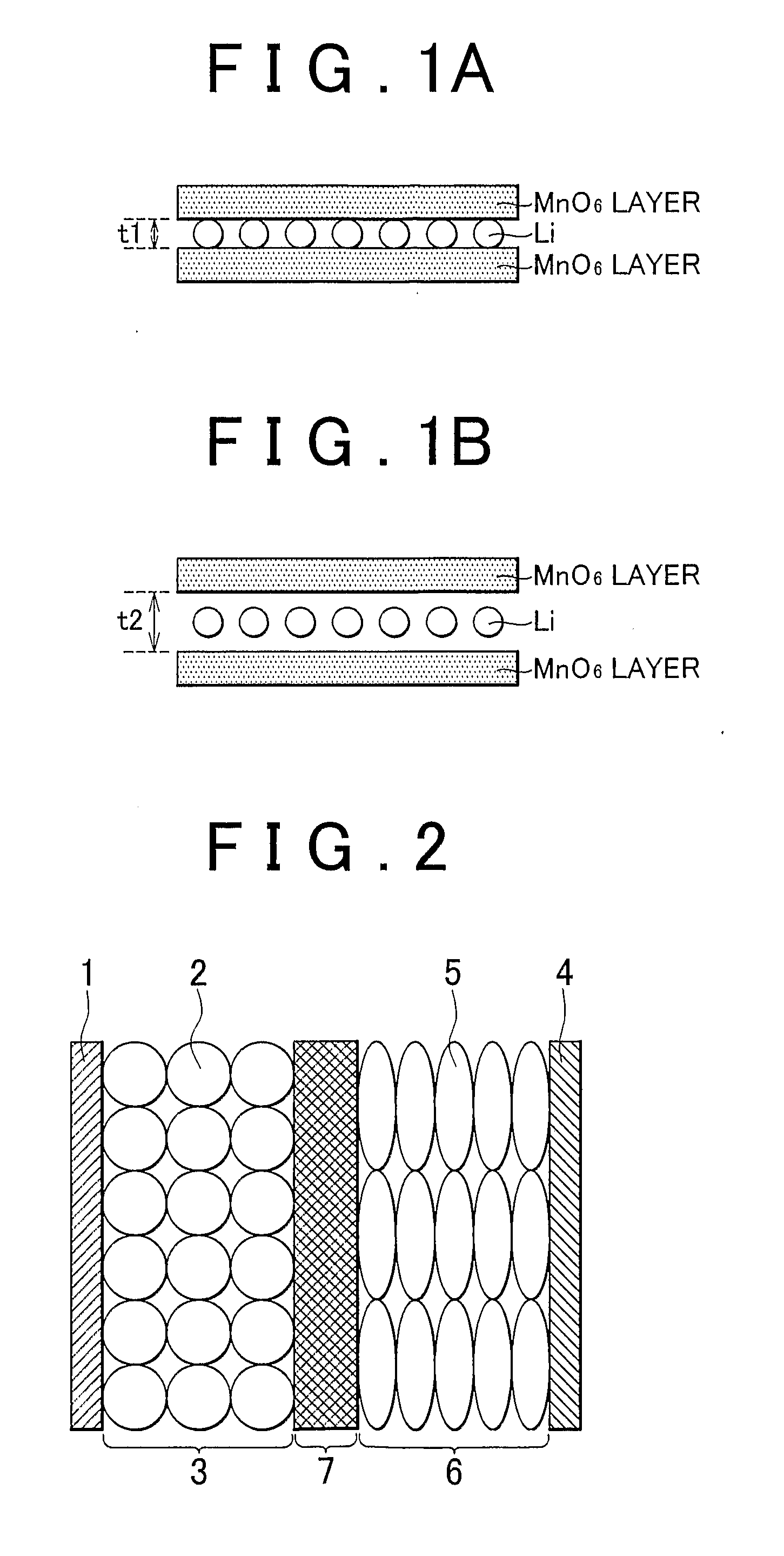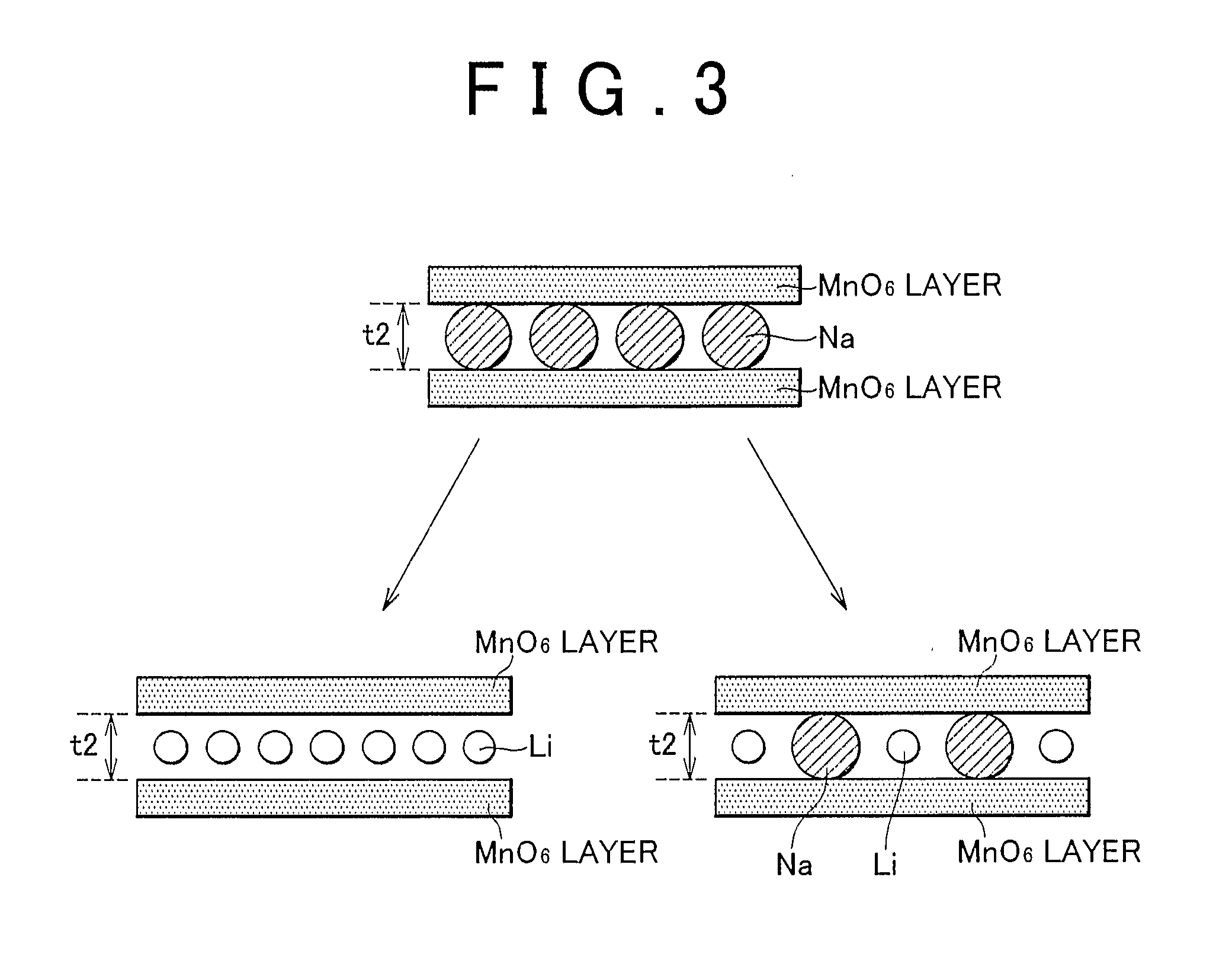Positive electrode active material, lithium secondary battery, and manufacture methods therefore
a positive electrode active material and lithium secondary battery technology, applied in the direction of cell components, final product manufacturing, sustainable manufacturing/processing, etc., can solve the problems of inability to achieve heightened output, low internal resistance, and hastened the development of electric motor vehicles, etc., to achieve excellent li-ion diffusibility, enhance output, and low internal resistance
- Summary
- Abstract
- Description
- Claims
- Application Information
AI Technical Summary
Benefits of technology
Problems solved by technology
Method used
Image
Examples
first embodiment
[0042]A positive electrode active material of the first embodiment is characterized by having an olivine structure, and being represented by LixM1-xMnPO4 (where 06 layers being larger than the inter-layer interval, of the MnO6 layers in LiMnPO4 as a reference substance.
[0043]According to the first embodiment, since the inter-layer interval of the MnO6 layers in the positive electrode active material is larger than the inter-layer interval of the MnO6 layers in LiMnPO4, which is the reference substance, the positive electrode active material can be made excellent in the Li-ion diffusibility inside active material. As the Li-ion diffusibility improves, the Li-ion diffusion resistance, which greatly contributes to the internal resistance, can be reduced, so that the internal resistance of the lithium secondary battery can be lowered and therefore the output can be heightened. Incidentally, many positive electrode active materials having a common olivine structure are inferior in the Li...
second embodiment
[0057] the positive electrode active material has two kinds of atoms, that is, Li, and an M that is larger in ion radius than Li, at the position of Li, as compared with a common active material of LiMnPO4. Therefore, the Li-ion migration path in the crystal structure can be made broad, so that the Li-ion diffusibility can be improved. Incidentally, a positive electrode active material having an olivine structure that has the foregoing composition is not generally known.
[0058]Besides, the positive electrode active material of the second embodiment can be obtained by, for example, firstly fabricating MMnPO4 that has an olivine structure through the use of an alkali metal element M (e.g., Na) that is larger in ion radius than Li, and then partially substituting the M contained in the structure, into Li, as in the positive electrode active material manufacture method described below. In this method, since the MMnPO4 having the olivine structure is firstly fabricated and then only a por...
third embodiment
[0062] a positive electrode active material excellent in the Li-ion diffusibility can be obtained by performing the positive electrode active material-forming material fabrication process and the substitution process.
[0063]The positive electrode active material-forming material fabrication process and the substitution process in the third embodiment are substantially the same as the content of the positive electrode active material manufacture method described below, and are omitted from the description herein.
[0064]Next, the lithium secondary battery of the invention will be described. The lithium secondary battery of the invention is characterized by having a positive electrode layer that contains the foregoing positive electrode active material, a negative electrode layer that contains a negative electrode active material, a separator disposed between the positive electrode layer and the negative electrode layer, and an organic electrolyte that conducts Li-ion between the positiv...
PUM
| Property | Measurement | Unit |
|---|---|---|
| particle diameter | aaaaa | aaaaa |
| particle diameter | aaaaa | aaaaa |
| temperature | aaaaa | aaaaa |
Abstract
Description
Claims
Application Information
 Login to View More
Login to View More - R&D
- Intellectual Property
- Life Sciences
- Materials
- Tech Scout
- Unparalleled Data Quality
- Higher Quality Content
- 60% Fewer Hallucinations
Browse by: Latest US Patents, China's latest patents, Technical Efficacy Thesaurus, Application Domain, Technology Topic, Popular Technical Reports.
© 2025 PatSnap. All rights reserved.Legal|Privacy policy|Modern Slavery Act Transparency Statement|Sitemap|About US| Contact US: help@patsnap.com



